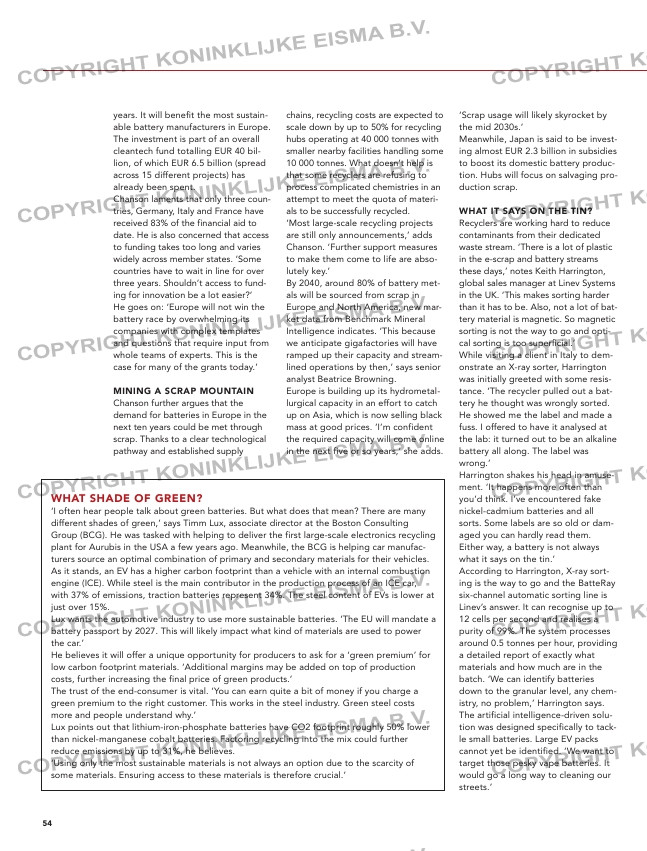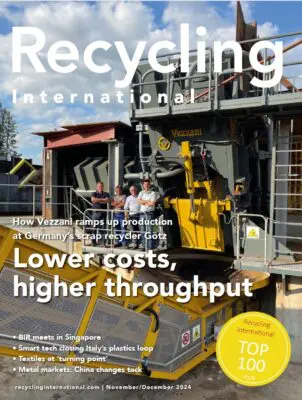Page 54 from: Recycling International November/December issue 2024

54
years. It will benefit the most sustain-
able battery manufacturers in Europe.
The investment is part of an overall
cleantech fund totalling EUR 40 bil-
lion, of which EUR 6.5 billion (spread
across 15 different projects) has
already been spent.
Chanson laments that only three coun-
tries, Germany, Italy and France have
received 83% of the financial aid to
date. He is also concerned that access
to funding takes too long and varies
widely across member states. ‘Some
countries have to wait in line for over
three years. Shouldn’t access to fund-
ing for innovation be a lot easier?’
He goes on: ‘Europe will not win the
battery race by overwhelming its
companies with complex templates
and questions that require input from
whole teams of experts. This is the
case for many of the grants today.’
MINING A SCRAP MOUNTAIN
Chanson further argues that the
demand for batteries in Europe in the
next ten years could be met through
scrap. Thanks to a clear technological
pathway and established supply
chains, recycling costs are expected to
scale down by up to 50% for recycling
hubs operating at 40 000 tonnes with
smaller nearby facilities handling some
10 000 tonnes. What doesn’t help is
that some recyclers are refusing to
process complicated chemistries in an
attempt to meet the quota of materi-
als to be successfully recycled.
‘Most large-scale recycling projects
are still only announcements,’ adds
Chanson. ‘Further support measures
to make them come to life are abso-
lutely key.’
By 2040, around 80% of battery met-
als will be sourced from scrap in
Europe and North America, new mar-
ket data from Benchmark Mineral
Intelligence indicates. ‘This because
we anticipate gigafactories will have
ramped up their capacity and stream-
lined operations by then,’ says senior
analyst Beatrice Browning.
Europe is building up its hydrometal-
lurgical capacity in an effort to catch
up on Asia, which is now selling black
mass at good prices. ‘I’m confident
the required capacity will come online
in the next five or so years,’ she adds.
‘Scrap usage will likely skyrocket by
the mid 2030s.’
Meanwhile, Japan is said to be invest-
ing almost EUR 2.3 billion in subsidies
to boost its domestic battery produc-
tion. Hubs will focus on salvaging pro-
duction scrap.
WHAT IT SAYS ON THE TIN?
Recyclers are working hard to reduce
contaminants from their dedicated
waste stream. ‘There is a lot of plastic
in the e-scrap and battery streams
these days,’ notes Keith Harrington,
global sales manager at Linev Systems
in the UK. ‘This makes sorting harder
than it has to be. Also, not a lot of bat-
tery material is magnetic. So magnetic
sorting is not the way to go and opti-
cal sorting is too superficial.’
While visiting a client in Italy to dem-
onstrate an X-ray sorter, Harrington
was initially greeted with some resis-
tance. ‘The recycler pulled out a bat-
tery he thought was wrongly sorted.
He showed me the label and made a
fuss. I offered to have it analysed at
the lab: it turned out to be an alkaline
battery all along. The label was
wrong.’
Harrington shakes his head in amuse-
ment. ‘It happens more often than
you’d think. I’ve encountered fake
nickel-cadmium batteries and all
sorts. Some labels are so old or dam-
aged you can hardly read them.
Either way, a battery is not always
what it says on the tin.’
According to Harrington, X-ray sort-
ing is the way to go and the BatteRay
six-channel automatic sorting line is
Linev’s answer. It can recognise up to
12 cells per second and realises a
purity of 99%. The system processes
around 0.5 tonnes per hour, providing
a detailed report of exactly what
materials and how much are in the
batch. ‘We can identify batteries
down to the granular level, any chem-
istry, no problem,’ Harrington says.
The artificial intelligence-driven solu-
tion was designed specifically to tack-
le small batteries. Large EV packs
cannot yet be identified. ‘We want to
target those pesky vape batteries. It
would go a long way to cleaning our
streets.’
‘BLACK SAND’
‘Urban mining is critical now more
than ever, that’s crystal clear,’ says
Robert Kang, ceo of Blue Whale
Materials in the US. ‘However, a circu-
lar system is much easier to talk about
than to realise’. Kang founded the
company in Bartlesville, Oklahoma,
nine years ago to help turn the tide.
It uses proprietary technology to pro-
duce ‘a very dry product’ that his
team refers to not as black mass but
‘black sand’. Up to 98% of high-quali-
ty cobalt and nickel is recovered from
lithium-ion batteries. ‘Our output is
optimised to serve hydrometallurgy
refining,’ Kang observes.
Blue Whale Materials has been dedi-
cated to R&D for years and is current-
ly building its first US pilot plant. It
will start operations in 2025 with
capacity around 25 000 tonnes a year.
A 93 000m2 battery material testing
facility and warehouse will also follow
next year.
‘Our big plans are the result of major
multi-billion grants from federal gov-
ernment in the last 12 months,’ Kang
states. ‘We are very thankful for this
backing, which will no doubt acceler-
ate recycling best practices.’ Recent
support includes being selected for
funding of US$ 55 (EUR 52 million) by
the US Department of Energy.
The recycler also benefits from
BWM’s EUR 103.5 million expansion
initiative that will allow it to process
at least 50 000 tonnes of battery
feedstock annually at the existing site
in Bartlesville. This partnership will
provide the carmaker with enough
critical minerals to power more than
100 000 electric vehicles per year. The
expanded operations will convert 3.5
times more end-of-life batteries and
production scrap into black mass than
currently.
‘MAD SCRAMBLE’
Kang hopes his firm’s new facilities
will alleviate the lack of domestic
refining. ‘US players are scrambling
like mad to find the missing link in the
value stream. To be frank, I fear that
even if more batteries are recycled
there will still not be enough volume
to reintroduce them into US produc-
WHAT SHADE OF GREEN?
‘I often hear people talk about green batteries. But what does that mean? There are many
different shades of green,’ says Timm Lux, associate director at the Boston Consulting
Group (BCG). He was tasked with helping to deliver the first large-scale electronics recycling
plant for Aurubis in the USA a few years ago. Meanwhile, the BCG is helping car manufac-
turers source an optimal combination of primary and secondary materials for their vehicles.
As it stands, an EV has a higher carbon footprint than a vehicle with an internal combustion
engine (ICE). While steel is the main contributor in the production process of an ICE car,
with 37% of emissions, traction batteries represent 34%. The steel content of EVs is lower at
just over 15%.
Lux wants the automotive industry to use more sustainable batteries. ‘The EU will mandate a
battery passport by 2027. This will likely impact what kind of materials are used to power
the car.’
He believes it will offer a unique opportunity for producers to ask for a ‘green premium’ for
low carbon footprint materials. ‘Additional margins may be added on top of production
costs, further increasing the final price of green products.’
The trust of the end-consumer is vital. ‘You can earn quite a bit of money if you charge a
green premium to the right customer. This works in the steel industry. Green steel costs
more and people understand why.’
Lux points out that lithium-iron-phosphate batteries have CO2 footprint roughly 50% lower
than nickel-manganese cobalt batteries. Factoring recycling into the mix could further
reduce emissions by up to 31%, he believes.
‘Using only the most sustainable materials is not always an option due to the scarcity of
some materials. Ensuring access to these materials is therefore crucial.’
52-53-54-55_batterycongress.indd 54 19-11-2024 13:18



